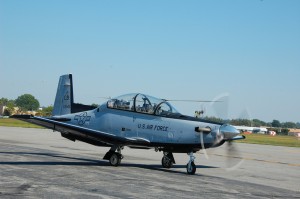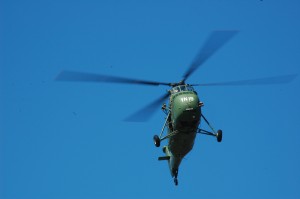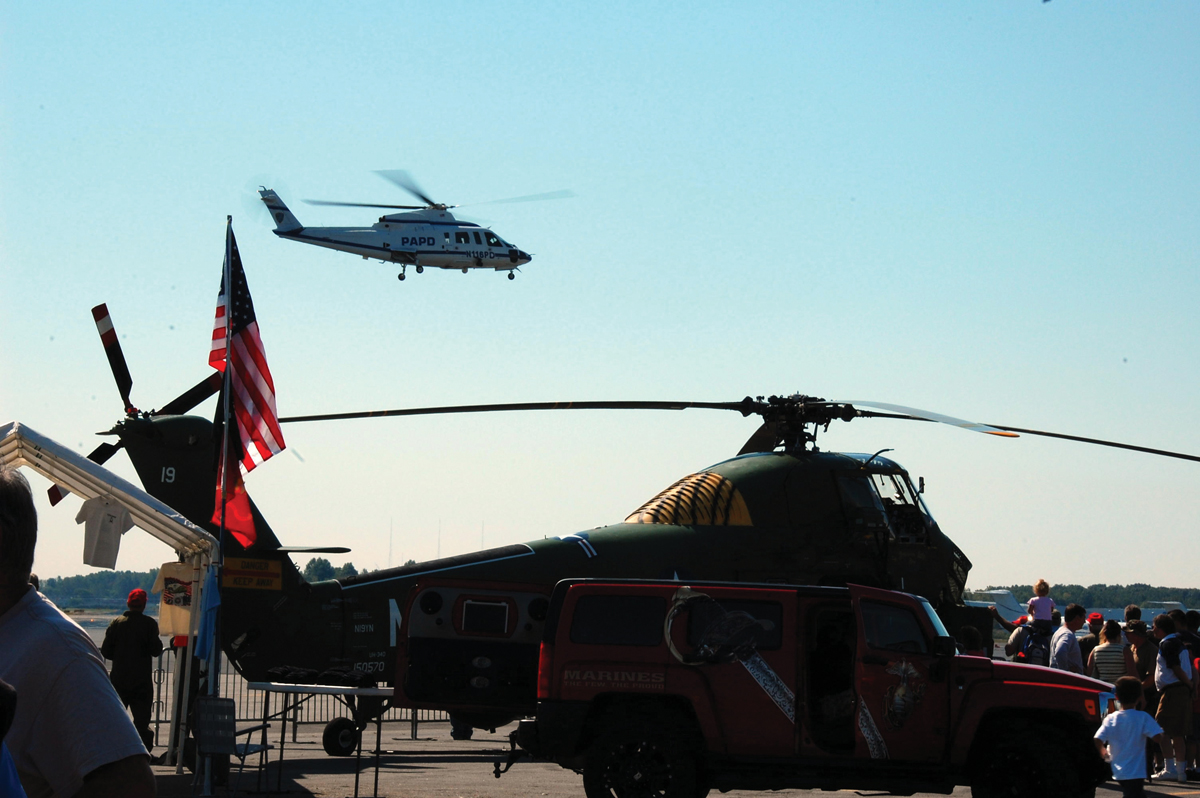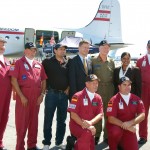
A Sikorsky S-76, owned by the Port Authority of New York and New Jersey, hovers in the background. The Marine Corps U-34 Choctaw in foreground made is first appearance at the show.
By Henry M. Holden
For more than 10 years, the Wings & Wheels Expo has been taking visitors back in time. This year, a crowd of more than 4,800 gathered to commemorate the heroic Berlin Airlift that saved more than two million men, women and children from starvation and death. The weather was perfect at the Aviation Hall of Fame and Museum of New Jersey (AHOF) at Teterboro Airport (TEB) and 2008’s attendance increased by 30 percent when compared to recent years.
“The idea was to provide a place where people can come and enjoy antique aircraft and cars,” said Shea Oakley, executive director of the AHOF.
This year’s show was the best this writer has seen in years. In addition to the return of the Boeing B-17 Yankee Lady, the Douglas C-47 Yankee Doodle (stable mates in the Yankee Air Force) and the Berlin Airlift Historical Foundation’s Douglas C-54E Spirit of Freedom, there were several newcomers. Attending for the first time was a Navy P-3 Orion, a U.S. Air Force T-6B, a pristine Spartan Executive, a Grumman OV-1 Mohawk and a Marine Corps U-34 Choctaw helicopter from the early days of the Vietnam War. Exotic and antique cars, motorcycles, military vehicles and a variety of general aviation aircraft were also on hand.
The B-17 was the world’s first strategic bomber. It allowed us to take the war directly to Nazi Germany and win the war in Europe.

This U.S. Air Force T-6B made its first appearance at this year’s event. The Beechcraft T-6B is a Joint Primary Aircraft Training System aircraft, with an advanced avionics suite that includes a head-up display and multifunction displays.
Yankee Lady was busy with rides for the visitors, available at $425 per person. This unforgettable 45-minute flight traveled up the Hudson River while passengers took in the spectacular fall foliage of the northern suburbs of New York City. At 10 passengers per flight, Yankee Lady made 16 sorties during the two-day event, a record for the show.
Members of the Army Air Forces Historical Association, based in northern New Jersey, are regulars at the annual exposition. They wear original flight gear and uniforms of the period and are not re-enactors, but rather living historians who paint a moving picture of the harrowing experiences of World War II veterans.
An impressive helicopter show
The Port Authority of New York and New Jersey base their Sikorsky S-76 helicopters at TEB. Visitors got to see one of the big choppers perform a thrilling 20-minute set of maneuvers that included reverse and lateral flight just a few feet off the ground. Several high-speed, low passes in front of the crowds had some folks gasping. Instead of landing, the air show announcer said that the big helicopter was called off on a mission. Later it returned, surprising everybody with another low pass before landing. A second Port Authority S-76 flew over the show to stun the crowd. Not to be outdone, the Marine Corps U-34 showed off its own style with some “Marine Corps” maneuvers, as the air show announcer called them.
Anniversary of the Berlin Airlift

The Boeing B-17 Yankee Lady is on a final approach. This year saw the Flying Fortress constantly in the air, flying 16 sorties during the two-day event.
The Spirit of Freedom was on hand to commemorate the 60th anniversary of the touching, humanitarian outreach known as the Berlin Airlift. It all began on June 24, 1948, when the Soviets cut off all land and water access to West Berlin. Over two million Berliners were threatened with the complete loss of food, water and fuel. The situation was desperate.
This year at Wings & Wheels, a celebration of German-American friendship took place in front of the Berlin Airlift Association’s Spirit of Freedom and included some veterans of the Airlift. Retired
U.S. Air Force Col. Gail Halvorsen, was nicknamed “The Candy Bomber and “Lt. Wiggly Wings” by the German children. As a young lieutenant, Halvorsen fashioned small parachutes for candy bars, which he dropped from his C-54. His idea caught on, and soon many other pilots joined in to drop nearly three tons of candy to the children during “Operation Little Vittles.”
The Con. Gen. of Germany for New York, Dr. Horst Freitag, attended the show to celebrate this important milestone.
“Under the motto and banner of ‘Friends Always,’ Germany and the United States commemorate a heroic effort that saved more than two million men, women and children from starvation and death,” Freitag said. “The Berlin Airlift laid the foundation of an enduring and strong friendship between the German and American people. On behalf of the German people, and especially of the people of Berlin, I feel honored to present the German-American Friendship Award to the veterans of the Berlin Airlift today.”

The Marine Corps Sikorsky U-34 is making a low pass over the crowd. This was its first appearance at the show since the Marine Helicopter Squadron 361 Veterans Association (working as Freedom’s Flying Memorial) restored it to flying condition.
The Berlin Airlift marked the beginning of the Cold War. The event wasn’t just part of Cold War history, it also helped establish the modern-day air traffic control system because of the sheer volume of planes involved.
“Gentlemen, your efforts were vital in accomplishing the seemingly impossible—you supplied a city for almost a year by air,” Freitag said. “You used friendship as a diplomatic weapon. In doing so, you won a strategic battle of the Cold War.”
The Airlift officially ended on Sept. 30, 1949, with U.S. and British forces delivering nearly two and a half million tons of food and resources during a combined 846 flights to Berlin, and the C-47s and C-54s flew over 92 million miles in order to do so. There were 101 fatalities, including 31 Americans, most due to crashes.
“The Allies got together and we started flying supplies in, incredible amount of supplies,” said Kevin Kearney, vice president of the Berlin Airlift Historical Foundation. “They needed 350 flights a day. The Berlin Airlift remains one of the most impressive and exceptional acts of humanity.”
- Aviation author and frequent Airport Journals contributor Jack Elliott was on hand to sign and sell his new book, “Adventures in Flying.” Elliott has been a journalist for more than 40 years.
- Retired U.S. Air Force Col. Gail Halvorsen chats with a fellow veteran of the Airlift. There were 101 fatalities, including 31 Americans who gave their lives to help the beleaguered people of West Berlin.
- Con. Gen. of Germany for New York, Dr. Horst Freitag (rear in suit), Col. Gail Halvorsen (to his left) and the crew of Spirit of Freedom pose for photographs. Freitag presented the German-American Friendship Award to the veterans of the Airlift.














